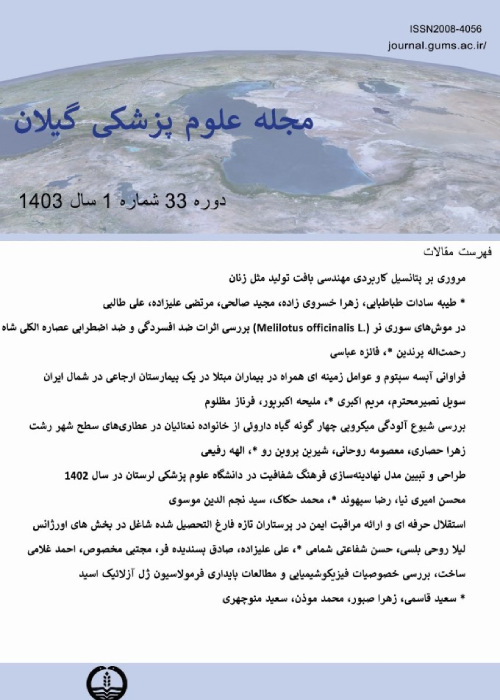Epidemiology of Addiction among Volunteered Addicts Attending in Detoxification Centers
Author(s):
Abstract:
Introduction
Prevalence of addiction imposes deep physical، psychological and social effects on Prevalence of addiction imposes deep physical، psychological and social effects on the society. From health and social viewpoints، addiction has a serious impact on the society because particularly، intravenous drug users is a main source of AIDS and HIV infection transmission in the community and the majority of prisoners commit drugs related crimes. Thus، it is important to identify the role of socio-demographic and cultural factors on the addictions for preventive purposes. Objective
The objective of this study was to investigate the epidemiologic aspects of addiction among volunteered addicts who tend to give up in Babol and Sari. Materials And Methods
This is a descriptive and analytic study of 1034 volunteered addicted subjects who took part in giving up in detoxification centers in Babol and Sari from 2003 till 2007. The existing data were extracted from charts of the patients using a designed questionnaire composed of two parts: First، demographic data (age، gender، job، education، residence area and marital status) and the second part included some specific data about the age of starting addition، the type of drug abuse، the reason for usage and giving up، disease background، the cost of consumption and duration of last period of consumption. The data were analyzed using SPSS software and Chi square test was used to find the related characteristics. Results
The results showed that 96. 6% of the addicts were men and just 3. 4% were women and average age (±SD) was 33 (±10) years. The mean age of starting addition was 21 (±7) years. The most prevalent age group of patients was 20-29 years (41. 8%) and the least age group belongs to 70 years or over. About 75% were living in urban area and most of them were married (68%). A quarter of the addicts were jobless and 40. 2% were self employed and more than 67% educated less than diploma. Opium was the most popular drug among them used by 74% followed by cocaine at the second rank (38. 6%). The most important reason for giving up addiction was social problems (39. 2%) and psychotic problems (28. 9%). The most common way of drug usage was smoking (73. 9%). Roughly، 72% of the addicts had giving up background. Using of opium (P=0. 05)، shireh (P=0. 04) and cocaine (P=0. 05) were significantly more common among men than women. The most popular way for giving up was MMT method (92. 3%). The most important reasons for addiction were associating with bad friends (45%) and temptation (15%). Conclusion
The results show that opium and cocaine are the most common substances used and the majority of addicts had history of giving up already that indicates the importance of prevention to treatment. Regarding the decreased starting age of addiction in our society، and its high prevalence among low educated and jobless individuals، the preventive educational program should be focused primarily on these high risk groups Conflict of interest: non declaredKeywords:
Language:
Persian
Published:
Journal Of Guilan University Of Medical Sciences, Volume:22 Issue: 87, 2013
Pages:
22 to 30
magiran.com/p1186656
دانلود و مطالعه متن این مقاله با یکی از روشهای زیر امکان پذیر است:
اشتراک شخصی
با عضویت و پرداخت آنلاین حق اشتراک یکساله به مبلغ 1,390,000ريال میتوانید 70 عنوان مطلب دانلود کنید!
اشتراک سازمانی
به کتابخانه دانشگاه یا محل کار خود پیشنهاد کنید تا اشتراک سازمانی این پایگاه را برای دسترسی نامحدود همه کاربران به متن مطالب تهیه نمایند!
توجه!
- حق عضویت دریافتی صرف حمایت از نشریات عضو و نگهداری، تکمیل و توسعه مگیران میشود.
- پرداخت حق اشتراک و دانلود مقالات اجازه بازنشر آن در سایر رسانههای چاپی و دیجیتال را به کاربر نمیدهد.
In order to view content subscription is required
Personal subscription
Subscribe magiran.com for 70 € euros via PayPal and download 70 articles during a year.
Organization subscription
Please contact us to subscribe your university or library for unlimited access!


